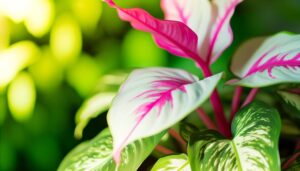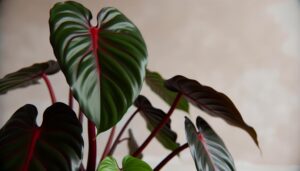What Is an Albo Heartleaf Philodendron?
The Albo Heartleaf Philodendron, a variegated cultivar of Philodendron hederaceum originating from Central and South American rainforests, features stunning cream and dark green patterned leaves. These heart-shaped leaves, typically 7-10 cm in length, result from selective breeding.
Ideal growth requires bright, indirect light, temperatures between 65-80°F (18-27°C), and high humidity (60-80%). A well-draining, slightly acidic soil with balanced nutrients and careful watering prevents root rot and nutrient burn.
Propagation is commonly performed using stem cuttings. For a thorough understanding, explore its care specifics and propagation techniques further.
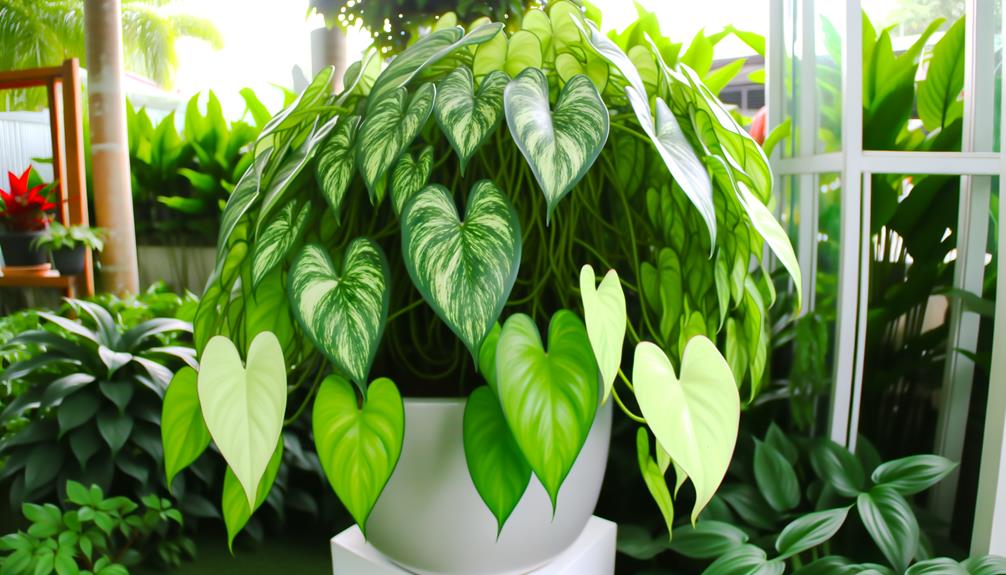
Key Takeaways
- Albo Heartleaf Philodendron is a variegated cultivar of Philodendron hederaceum.
- It features heart-shaped leaves with striking cream and dark green variegation.
- The plant thrives in bright, indirect light and high humidity levels.
- It requires well-draining, slightly acidic soil and consistent moisture.
- Propagation is commonly done through stem cuttings with aerial roots.
Origin and Background
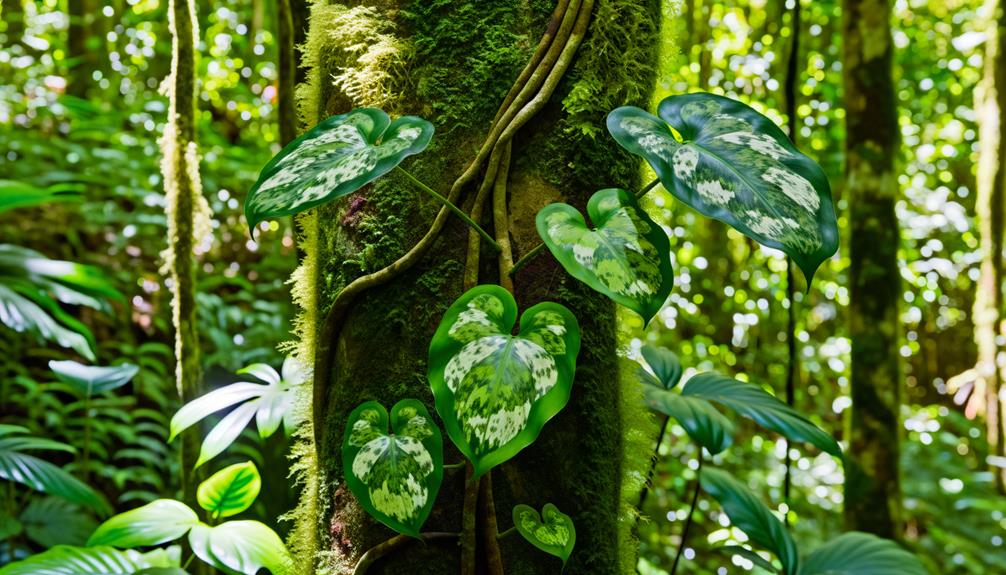
Originating from the tropical rainforests of Central and South America, the Albo Heartleaf Philodendron (Philodendron hederaceum var. oxycardium 'Albo-variegata') is a variegated cultivar known for its striking foliage and adaptability to indoor environments.
This cultivar is derived from the species Philodendron hederaceum, a climbing vine that thrives in the understory layer of dense, humid forests. The 'Albo-variegata' variant has been selectively bred to exhibit unique variegation patterns, characterized by its cream-colored patches contrasting with dark green leaves.
The species' natural epiphytic growth habit allows it to efficiently utilize available light and moisture, making it a resilient houseplant. Its adaptability and ease of propagation have contributed to its popularity among indoor plant enthusiasts and collectors.
Unique Features
The Albo Heartleaf Philodendron is distinguished by its striking variegation, where the leaves feature irregular patterns of cream and dark green, a result of its unique chlorophyll distribution. This phenomenon occurs due to genetic mutations which inhibit chlorophyll production in certain leaf areas, creating the characteristic variegated appearance.
The leaves are typically heart-shaped, measuring approximately 7-10 cm in length and 5-7 cm in width, enhancing their ornamental appeal. The plant exhibits a climbing habit, facilitated by aerial roots that anchor it to support structures.
Additionally, the Albo Heartleaf Philodendron displays heterophyllous foliage, with juvenile leaves differing in form and texture from mature ones. These features collectively contribute to its desirability among plant enthusiasts and collectors.
Ideal Growing Conditions

Given its remarkable aesthetic appeal, understanding the ideal growing conditions for the Albo Heartleaf Philodendron is crucial to maintaining its variegated beauty and overall health.
This plant thrives in environments with indirect, bright light, as direct sunlight can damage its delicate leaves. Best temperature ranges between 65-80°F (18-27°C), with high humidity levels around 60-80% to replicate its native tropical habitat.
The soil should be well-draining, rich in organic matter, and slightly acidic with a pH of 5.5-6.5. Sufficient air circulation is vital to prevent fungal infections. Use a potting mix containing peat, perlite, and orchid bark to ensure proper aeration and moisture retention.
Maintaining these conditions will support vigorous growth and vibrant foliage.
Watering and Feeding
Proper watering and feeding practices are essential for sustaining the Albo Heartleaf Philodendron's health and promoting its variegated foliage. This Philodendron prefers a consistently moist but not waterlogged substrate. Irrigation should be conducted when the top inch of soil feels dry, ensuring thorough saturation while allowing excess water to drain. Employing a well-aerated potting mix can mitigate root rot.
Nutrient supplementation should be approached with a balanced, water-soluble fertilizer, applied bi-monthly during the growing season. A formulation with an equal ratio of nitrogen, phosphorus, and potassium (e.g., 20-20-20) is recommended to support robust growth and vibrant leaf variegation. Avoid over-fertilization, as it may lead to nutrient burn and diminish the plant's aesthetic appeal.
Propagation Methods
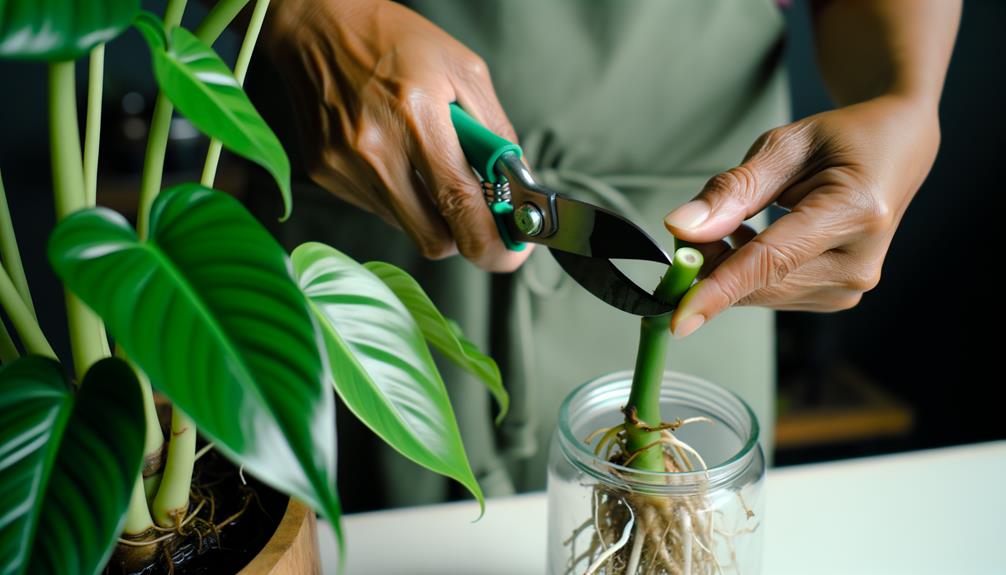
Propagation of the Albo Heartleaf Philodendron can be effectively achieved through stem cuttings, which allows for the perpetuation of its desirable variegated characteristics. This method involves selecting a healthy, mature stem with at least one node and an aerial root.
Utilize sterile pruning shears to cut below the node, ensuring a clean incision to prevent pathogen entry. The cutting should then be placed in water or a well-draining propagation medium such as perlite or sphagnum moss. Maintain high humidity and consistent moisture levels to facilitate root development.
Once substantial root growth is evident, typically within 4-6 weeks, the cutting can be transplanted into nutrient-rich, well-aerated potting soil to encourage robust growth.
Common Problems and Solutions
When cultivating Albo Heartleaf Philodendron, several common issues can arise:
- Yellowing leaves
- Root rot
- Pest infestations
Understanding the reasons behind yellowing leaves, including nutrient deficiencies and improper lighting, is essential. Additionally, employing efficient root rot prevention techniques and pest infestation control measures promotes the plant's best health and longevity.
Yellowing Leaves Causes
Yellowing leaves on an Albo Heartleaf Philodendron can be attributed to several common issues, including improper watering, inadequate light, nutrient deficiencies, and pest infestations, each necessitating specific corrective measures to restore plant health.
Overwatering often leads to waterlogged soil, causing chlorosis and compromised root function. Conversely, underwatering results in desiccation and reduced photosynthetic efficiency.
Inadequate light, particularly low light, diminishes chlorophyll production, leading to pale foliage. Nutrient deficiencies, especially nitrogen, manifest as generalized chlorosis, while micronutrient imbalances may cause interveinal yellowing.
Pest infestations, including spider mites and aphids, disrupt cellular integrity and sap essential nutrients. Diagnosing the exact cause through careful observation and tailored interventions is fundamental for maintaining the vibrant variegation and overall vigor of the Albo Heartleaf Philodendron.
Root Rot Prevention
Preventing root rot in Albo Heartleaf Philodendron involves meticulous management of soil moisture levels and ensuring proper drainage to inhibit the proliferation of pathogenic fungi and bacteria. Best soil composition should include well-aerated substrates such as perlite or orchid bark, mixed with peat-based potting soil to enhance drainage.
Regularly monitor moisture levels using a soil moisture meter, aiming to keep the medium moderately moist but never waterlogged. Employ pots with ample drainage holes to facilitate excess water expulsion. Avoid overwatering by allowing the top inch of soil to dry out between waterings.
Implementing these practices minimizes the risk of anaerobic conditions conducive to root rot, thereby promoting healthy root systems and overall plant vigor.
Pest Infestation Control
Effective pest infestation control in Albo Heartleaf Philodendron necessitates the identification and management of common pests such as aphids, spider mites, and mealybugs. These pests can cause significant damage through sap extraction, leading to stunted growth and chlorosis. Early detection is essential. Inspect the undersides of leaves and stems regularly. Integrated Pest Management (IPM) strategies, including natural predators like ladybugs for aphids, neem oil for spider mites, and rubbing alcohol for mealybugs, are recommended. Chemical pesticides should be a last resort due to potential phytotoxicity.
| Pest Type | Symptoms | Control Method |
|---|---|---|
| Aphids | Yellowing, distorted leaves | Natural predators, neem oil |
| Spider Mites | Fine webbing, speckled leaves | Neem oil, miticides |
| Mealybugs | White cottony masses | Rubbing alcohol, insecticidal soap |
Regular monitoring and timely intervention are vital for maintaining plant health.
Conclusion
The Albo Heartleaf Philodendron, characterized by its variegated leaves and distinctive white patterns, thrives under specific conditions akin to a well-tuned instrument playing a harmonious melody.
Its propagation and maintenance require precise techniques to promote growth at its best. Addressing common issues with targeted solutions preserves the plant's health and aesthetic appeal.
Through scientific understanding and meticulous care, the Albo Heartleaf Philodendron can flourish, exemplifying nature's intricate beauty and adaptability within controlled environments.

